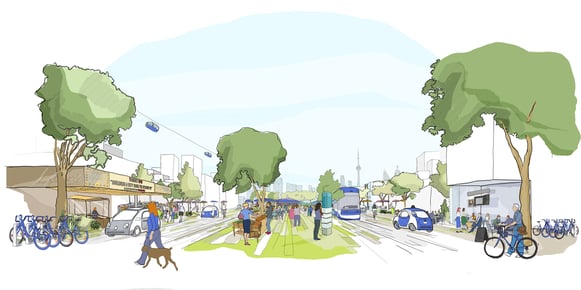On Tuesday, October 17, Canadian Prime Minister Justin Trudeau, along with executives from Google’s parent company, Alphabet, announced a $1 billion plan called Sidewalk Toronto.

What is Sidewalk Toronto?
In short, it’s an 800-acre “beta city” project that will be the first development by Alphabet’s Sidewalk Labs. The goal of the project, which will be located on the city’s eastern waterfront, is to be:
A new type of place that combines the best in urban design with the latest in digital technology to address some of the biggest challenges facing cities, including energy use, housing affordability, and transportation… A place that encourages innovation around energy, waste, and other environmental challenges to protect the planet. [Source]
Okay, so what will it actually be?
Well, based on that data and information available from Sidewalk Labs, the Sidewalk Toronto project could include:
1. Self-driving technology and digital navigation tools [that] can give rise to a next-generation, point-to-point transit system that complements pedestrian, cycling, and bus or rail options to improve convenience, reduce costs, and enhance street safety.
2. Housing and real estate that is more efficient and thus far more affordable. New construction methods and flexible building designs enable radical mixed-use, walkable neighborhoods that reduce the cost of housing and retail space.
3. A new standard of sustainability. A suite of design and infrastructure innovations can dramatically reduce building energy consumption, landfill waste, and carbon emissions—creating a blueprint for truly climate-positive neighborhoods. [Source]
Through these advancements, Sidewalk Labs hopes to reduce pollution, commute times and landfill waste to improve the weather. It envisions reducing the impact of wind, increasing shade on sunny days and blocking rain due to smart building design and tree planting. [Source]
This is just...cool.
3 Reasons You Should Be Paying Attention:
1. Smart cities will mean a different type of energy demand. Though buildings will be made to be more efficient, everything from electric and autonomous transportation to digitally connected city service systems could shift demand load and customer expectations.
2. The utility of the future may have just gotten funded. We don't know what the end product of Sidewalk Toronto will be. But it's possible that it could be a state-funded blueprint for the utility of the future and urban planning.
3. Because Alphabet Executive Chairman Eric Schmidt said this...“This is not some random activity from our perspective. This is the culmination, from our side, of almost 10 years of thinking about how technology can improve people’s lives.” [Source]
Sidewalk Toronto will be the first of its kind, but it likely won't be the last. If it’s a success, how many other places will be vying for a chance to become Google's next “smart” city? Will they be in your territory?
Are you ready?


